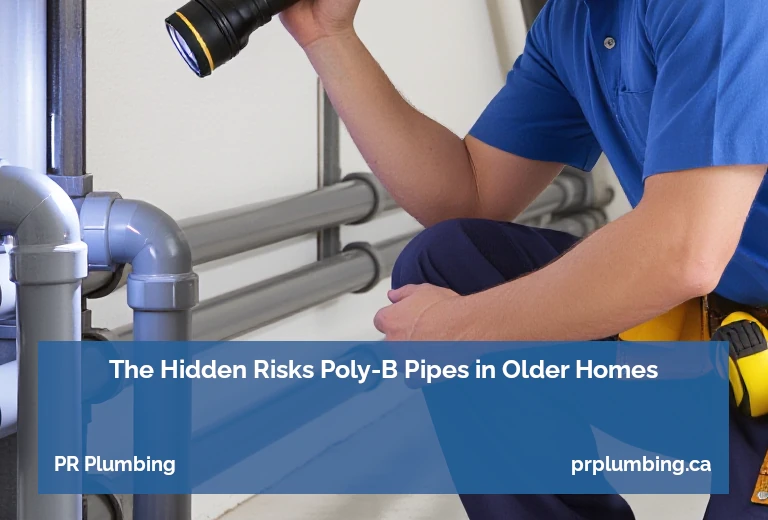If your home was built between the late ‘70s and late ‘90s, there’s a good chance that you have poly-b pipes. These pipes were widely installed for years, but now they are known for weakening over time and failing without warning. Even if your plumbing seems to be working fine, Poly-B can turn into a costly problem when you least expect it.
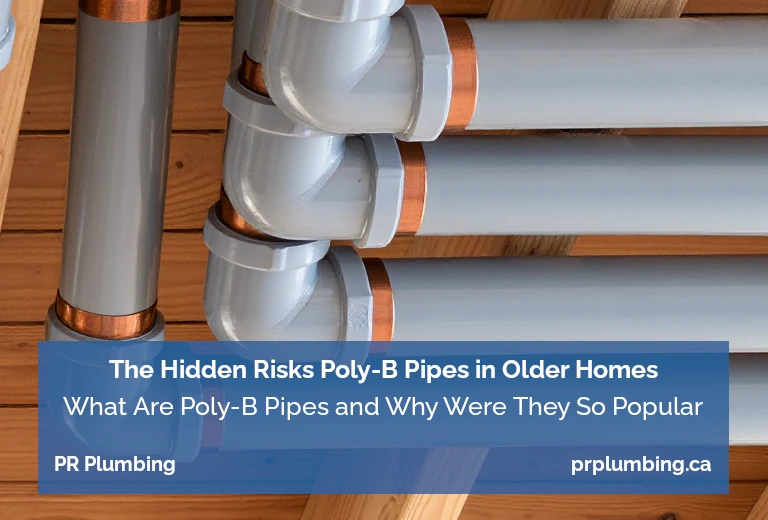
What Are Poly-B Pipes and Why Were They So Popular
Polybutylene (Poly-B) plumbing was once considered a breakthrough material. Builders loved it because:
- It was inexpensive
- It was easy to install
- It required very few tools
- It resisted corrosion better than metal
- It significantly sped up construction timelines
For decades, Poly-B seemed like the perfect plumbing solution. But over time, homeowners began reporting leaks, sudden pipe failures, and pinhole bursts. Investigations revealed the piping degraded when exposed to chlorine, high water temperatures, and mechanical stress.
This combination created the perfect storm for premature failure.

Why Poly-B Pipes Are Failing Today
1- Chemical Breakdown
Polybutylene becomes brittle when exposed to disinfectants like chlorine. Chlorine is found in almost every municipal water system in Ontario. As the pipes age, they lose flexibility, making cracks and ruptures more likely.
2- Weak Plastic Fittings
Some installations used plastic fittings rather than metal ones, and these fittings were far weaker than the piping itself. They often degrade from the inside out, making failures unpredictable.
3- Improper Installations
Because the system was “easy” many inexperienced installers handled the work. Sharp bends, overtightened fittings, and poorly supported joints have turned into failure points decades later.
4- High Water Pressure
Even when homes have a pressure regulator, many older ones drift out of calibration. Unchecked pressure increases wear on polybutylene and can lead to sudden ruptures.
5- Temperature Issues
Homes with older water heaters may unintentionally run at high temperatures. Heat accelerates the breakdown of Poly-B and increases the chance of leaks.
How to Identify Poly-B Pipes in Your Home
Polybutylene is surprisingly easy to spot when you know what to look for:
- The pipes are light grey
- The texture is slightly flexible and plastic-like
- Pipes are usually between ½” and 1” in diameter
- Fittings may either be plastic or copper
- It often connects to a copper pipe with a visual transition joint
- Common locations include basements, utility rooms, behind washing machines, under sinks, and along unfinished ceilings.
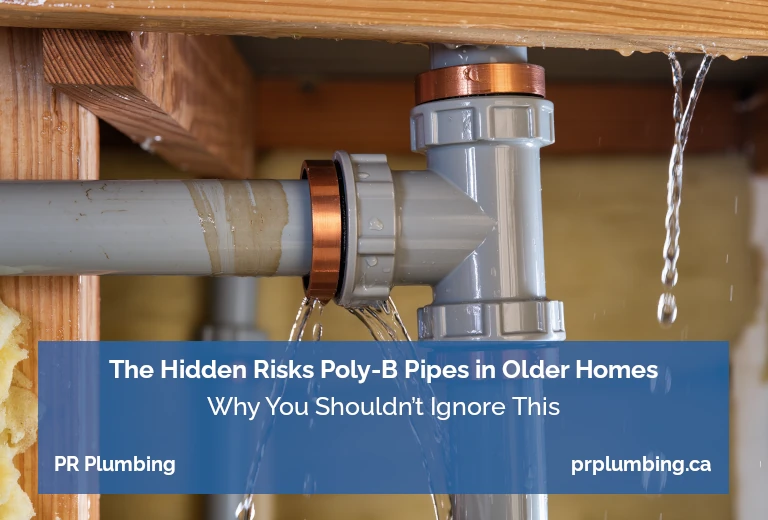
Why You Shouldn’t Ignore This
It’s tempting to assume that aging plumbing is safe, until it fails. But, poly-b pipes do not fail slowly. They fail catastrophically. Many homeowners only discover the problem when:
- A finished basement floods
- Ceilings collapse
- A slow pinhole leak causes hidden mould
- An insurance claim is denied
Some insurance companies have begun to restrict coverage or increase premiums for homes with Poly-B. Others require full replacement to maintain coverage.
Replacing the pipes proactively is significantly cheaper than repairing water damage.
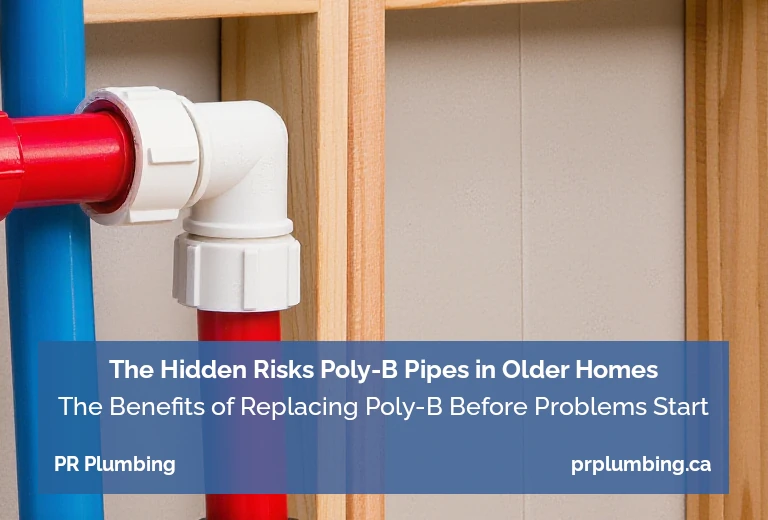
The Benefits of Replacing Poly-B Before Problems Start
Replacing Poly-B isn’t just about preventing disaster. It can improve your home’s plumbing efficiency and long-term value.
1- Better Water Pressure & Flow
Modern PEX piping handles pressure fluctuations well and maintains consistent flow throughout your home.
2- Higher Home Resale Value
Real estate buyers in Ontario are increasingly aware of Poly-B risks. Removing it eliminates a major red flag.
3- Lower Insurance Complications
A modern plumbing system can help you avoid premium spikes or claim denials.
4- Peace of Mind
No homeowner wants to lie awake listening for drips behind walls. Replacing Poly-B removes that uncertainty completely.
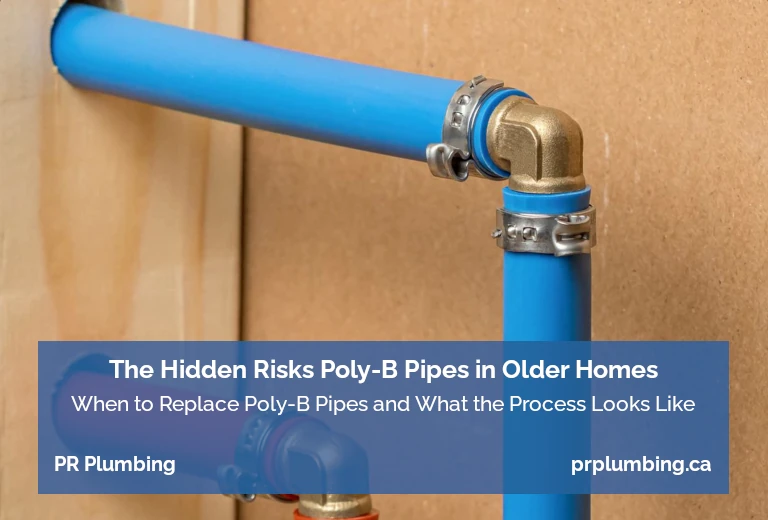
When to Replace Poly-B Pipes and What the Process Looks Like
Replacing Poly-B is not as invasive as many homeowners fear. Modern plumbing contractors use techniques that minimize damage to walls and reduce downtime.
A professional plumber will:
1- Inspect your current plumbing
2- Identify all Poly-B lines
3- Plan the least disruptive route for new pipes
4- Replace fixtures or shut-offs if needed
5- Test the new system thoroughly
6- Patch and repair access points
Most home repipes take 1-3 days depending on size and complexity.
Protect Your Home Before Poly-B Becomes a Problem
Even if everything seems fine today, aging poly-b pipes are a known risk. Their material weaknesses and decades of exposure to municipal water treatment make them increasingly unreliable. Replacing them proactively protects your home, prevents water damage, and safeguards your insurance coverage.
If you’re worried about polybutylene pipes in your home, PR Plumbing can help. Call us on (905) 706-5325.
